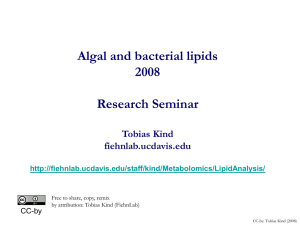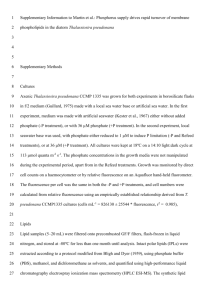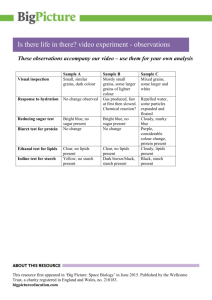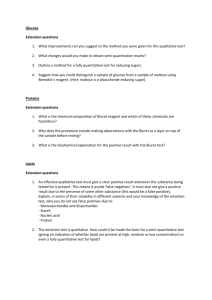influence of 1-chloro-4 benzyl-phtalazine on some polar - uni
advertisement
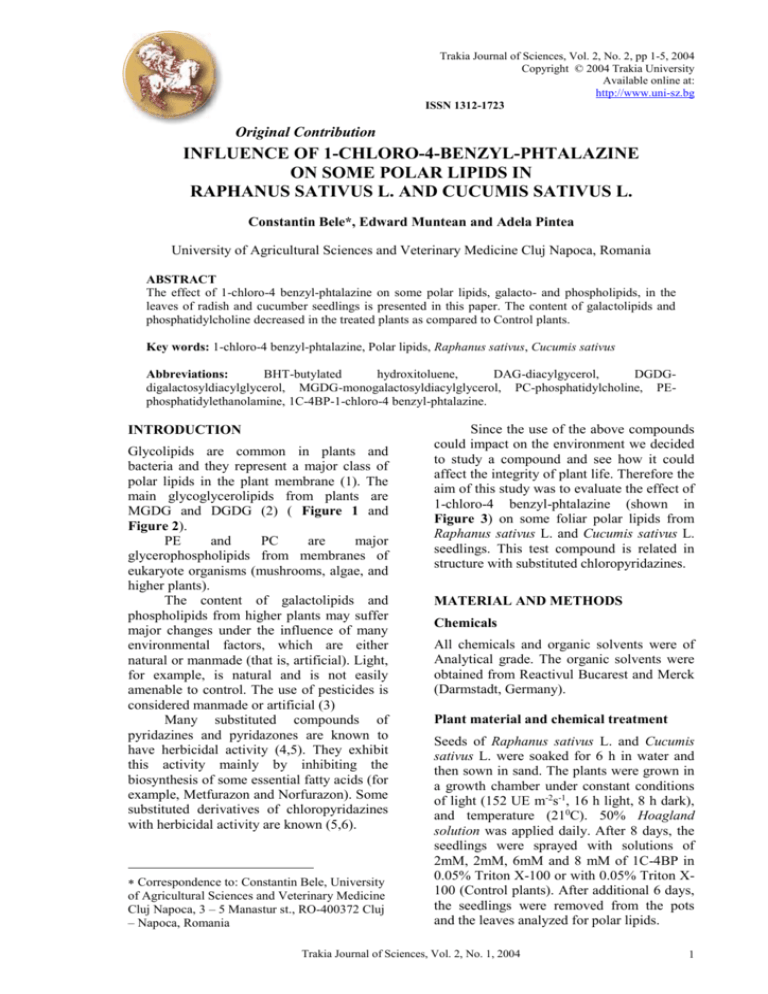
Trakia Journal of Sciences, Vol. 2, No. 2, pp 1-5, 2004 Copyright © 2004 Trakia University Available online at: http://www.uni-sz.bg ISSN 1312-1723 Original Contribution INFLUENCE OF 1-CHLORO-4-BENZYL-PHTALAZINE ON SOME POLAR LIPIDS IN RAPHANUS SATIVUS L. AND CUCUMIS SATIVUS L. Constantin Bele*, Edward Muntean and Adela Pintea University of Agricultural Sciences and Veterinary Medicine Cluj Napoca, Romania ABSTRACT The effect of 1-chloro-4 benzyl-phtalazine on some polar lipids, galacto- and phospholipids, in the leaves of radish and cucumber seedlings is presented in this paper. The content of galactolipids and phosphatidylcholine decreased in the treated plants as compared to Control plants. Key words: 1-chloro-4 benzyl-phtalazine, Polar lipids, Raphanus sativus, Cucumis sativus Abbreviations: BHT-butylated hydroxitoluene, DAG-diacylgycerol, DGDGdigalactosyldiacylglycerol, MGDG-monogalactosyldiacylglycerol, PC-phosphatidylcholine, PEphosphatidylethanolamine, 1C-4BP-1-chloro-4 benzyl-phtalazine. INTRODUCTION Glycolipids are common in plants and bacteria and they represent a major class of polar lipids in the plant membrane (1). The main glycoglycerolipids from plants are MGDG and DGDG (2) ( Figure 1 and Figure 2). PE and PC are major glycerophospholipids from membranes of eukaryote organisms (mushrooms, algae, and higher plants). The content of galactolipids and phospholipids from higher plants may suffer major changes under the influence of many environmental factors, which are either natural or manmade (that is, artificial). Light, for example, is natural and is not easily amenable to control. The use of pesticides is considered manmade or artificial (3) Many substituted compounds of pyridazines and pyridazones are known to have herbicidal activity (4,5). They exhibit this activity mainly by inhibiting the biosynthesis of some essential fatty acids (for example, Metfurazon and Norfurazon). Some substituted derivatives of chloropyridazines with herbicidal activity are known (5,6). Since the use of the above compounds could impact on the environment we decided to study a compound and see how it could affect the integrity of plant life. Therefore the aim of this study was to evaluate the effect of 1-chloro-4 benzyl-phtalazine (shown in Figure 3) on some foliar polar lipids from Raphanus sativus L. and Cucumis sativus L. seedlings. This test compound is related in structure with substituted chloropyridazines. MATERIAL AND METHODS Chemicals All chemicals and organic solvents were of Analytical grade. The organic solvents were obtained from Reactivul Bucarest and Merck (Darmstadt, Germany). Correspondence to: Constantin Bele, University of Agricultural Sciences and Veterinary Medicine Cluj Napoca, 3 – 5 Manastur st., RO-400372 Cluj – Napoca, Romania Plant material and chemical treatment Seeds of Raphanus sativus L. and Cucumis sativus L. were soaked for 6 h in water and then sown in sand. The plants were grown in a growth chamber under constant conditions of light (152 UE m-2s-1, 16 h light, 8 h dark), and temperature (210C). 50% Hoagland solution was applied daily. After 8 days, the seedlings were sprayed with solutions of 2mM, 2mM, 6mM and 8 mM of 1C-4BP in 0.05% Triton X-100 or with 0.05% Triton X100 (Control plants). After additional 6 days, the seedlings were removed from the pots and the leaves analyzed for polar lipids. Trakia Journal of Sciences, Vol. 2, No. 1, 2004 1 BELE C. et al. CH2 OH OH CH2 OH OH O OH O CH2 O OH OH O OH OH CH2 HC O CO R1 H2C O CO R2 O OH O OH Figure I: Structure of MGDG CH2 HC O CO R1 H2C O CO R2 Figure 2: Structure of DGDG CH2 N N Cl Figure 3. Structure of 1-chloro-4 benzyl-phtalazine Lipid extraction The leaf was boiled for 5 min in 0.05% (w/v) BHT in isopropanol according to the method of Kates (7). After cooling on ice, the remaining alcohol was evaporated under N2 (g), and the lipids were extracted using a method introduced by by Schacht (8) but in a modified form. Briefly, the sample was homogenized in chloroform:methanol:water 1:2:0.8 (v/v/v) using an Ultra Turrax (Janke and Kunkel, Germany). The leaf homogenate was stored in darkness for 30 min at room temperature prior to vacuum filtration using a Buchner funnel. The filtering element was washed with chloroform : methanol:water 1:2:0.8 (v/v/v) and twice with 0.05% (w/v) BHT in chloroform. To the combined filtrate 1.6 M HCl was added to give the final composition of chloroform : methanol:1.0 M HCl 2:2:1.8 (v/v/v). After phase separation the lower phase was collected and the remaining upper phase re-extracted twice with 0.05% (w/v) BHT in chloroform. The lipid extract was washed twice with 1.0 M HCl : methanol 1:1 (v/v) and dried under N2 (g). The lipids were dissolved in chloroform and stored at – 200C. 2 Separation of foliar lipids by column chromatography A glass column with activated Silica Gel 60 was used. Neutral lipids were eluted with chloroform, glycolipids with acetone and acetone: acetic acid: water mixture (100:2:1, v/v). Phospholipids were eluted with methanol: chloroform mixture (1:1, v/v) and then with only methanol. All fractions were subsequently analyzed using TLC. Separation of polar lipids by TLC Aliquots of the lipid extract were separated using TLC with activated Silica Gel 60 plates (Merck). Polar lipids were separated with methyl acetate: isopropanol: chloroform: methanol: KCl aqueous solution (25:25:28:10:7, v/v). Determination of phosphorus from phospholipids Spectrophotometric method with ammonium molybdate at 830 nm wavelength was used in this determination (4). Trakia Journal of Sciences, Vol. 2, No. 2, 2004 BELE C. et al. Determination galactolipids of galactose example, MGDG and DGDG were restricted to the plastid membranes where they have been reported to account for approximately 40-50% and 20-30% respectively, of the lipids of thylakoids (9). PC is one of the major lipids of non-plastid membranes. Recent evidence suggests that PC may be absent from thylakoids, while it is a constituent of at least the outer envelope membrane (10). This uneven distribution of membrane lipid classes among different organelles of membrane allowed us to draw conclusions regarding subcellular localization of chemical treatment using 1C – 4BP even though the data were obtained for total lipids. The content in galactolipids (MGDG and DGDG) but also in PC decreased in Raphanus sativus L. leaves treated with 1C – 4BP as compared with Control seedlings (Figure 4 and Figure 5). from Chloroform extracts of galactolipids obtained from TLC plates were treated with distilled water, agitated and then 5% phenol solution and sulphuric acid were added and shaken. The absorbance of the resulting orange solution was read spectrophotometrically at 490 nm against an appropriate blank solution (4). For calibration, standards containing 20, 40, and 80 µg of glucose, or a mixture of other hexoses, are run simultaneously. RESULTS AND DISCUSSIONS The present data were from 3 independent experiments. Lipids were extracted from leaf tissue without any prior subfractionation of the tissue into organelles or defined membrane fractions. However, several acyl lipid classes were not evenly distributed among the different plant membranes. For 600 500 400 MGDG 300 DGDG 200 100 0 1 2 3 4 5 1 – control, 2 – 2mM, 3 – 4 mM, 4 – 6 mM, 5 – 8 mM Figure 4. Influence of 1C – 4BP, on MGDG and DGDG content (g/g.f.w) in leaves of Raphanus s. 400 300 200 PC 100 0 1 2 3 4 5 1 – control, 2 – 2mM, 3 – 4 mM, 4 – 6 mM, 5 – 8 mM Figure 5. Influence of 1C – 4BP, on PC content (g/g.f.w) in leaves of Raphanus sativus L. seedlings Leaves of radish seedlings treated with 2mM 1C – 4BP contained about 84% MGDG compared to the Control plants. A four times increase in this concentration (8mM 1C – 4BP, to be precise) brought the MGDG content to a decreased level of only 65.8% of Control seedlings. The DGDG content in radish seedlings was lower than the MGDG values in both Control and 1C – 4BP-treated seedlings. The DGDG content in Control plants was Trakia Journal of Sciences, Vol. 2, No. 2, 2004 3 BELE C. et al. 420µg/g f.w. This was about 72.4% of the MGDG content. The DGDG content in plants treated with 2mM 1C-4BP was 90.4% of that in Control plants, and with 8mM 1C – 4BP treatment the DGDG content decreased to 75% of that in Control plants. It is generally believed that fall in galactolipids content modifies the structure of thylakoids (4). It is important to note that the MGDG/DGDG ratio was 1.38 in Control plants. This ratio changed in the Test plants with the application of 1C-4BP at an increasing concentration as follows: 1.28 at 2 mM 1C – 4BP and 1.21 at 8 mM 1C – 4BP. This changing ratio, with respect to MGDG/DGDF, has been mentioned elsewhere in the case of other stress factors like ozone on polar lipids on leaves (11,12). An ozone-related decrease in the MGDG/DGDG ratio has been observed for spinach and kidney bean. In spinach, the ozone-induced decrease in the MGDG/DGDG ratio was shown to be caused by stimulation of galactolipid: galactolipid galactosyl-transferase (3), which catalyses the transfer of a galactose moiety from one MGDG molecule to another, thus creating DGDG and DAG molecules (14). Our treatment with 1C-4BP could have also stimulated this enzyme. The PC content from radish leaves was lower in seedlings treated with 1C-4BP, compared to Control seedlings. Thus with the 2mM and 8mM 1C-4BP administered to seedlings, the PC contents were 92.3% and 76.3%, respectively, as compared with Control seedlings. A similarity was observed in changes in galactolipids and phosphatidylcholine contents in leaves from plants treated with 1C-4BP, and those produced in leaf senescence. The leaves of watercress (Rorippa nasturtium-aquaticum) showed concomitant changes in the contents of chlorophyll and of phospholipids and galactolipids (15). In this case, the decrease in galactolipid content (MGDG and DGDG) was more pronounced than that observed for phospholipids. The apparent similarity between changes resulting from natural senescence process with those observed in some stress situations points out a possible common mechanism of action (4). Changes in contents of MGDG, DGDG, and PC in leaves of Cucumis sativus L. were shown in Figure 6. 700 600 500 400 MGDG 300 DGDG 200 PC 100 0 1 2 3 4 5 1 – control, 2 – 2mM, 3 – 4 mM, 4 – 6 mM, 5 – 8 mM Figure 6. Influence of 1C – 4BP on MGDG, DGDG and PC content (g/g.f.w).in leaves of Cucumis sativus L. seedlings The results discussed above, concerning the influence of 1C-4BP on some foliar polar lipids from radish seedlings, can also apply to cucumber seedlings thus suggesting a common mechanism of action of this chemical compound. Our findings with two other phtalazinic derivatives related to 1C-4BP, which are 1-chloro-4-tolylphtalazine and 1chloro-4-phenylphtalazine, showed no significant changes from the results obtained so far (data not shown). This demonstrates the lower influence of substituents from 4 position 4 of phtalazinic nucleus on biologic activity of these compounds. Several assumptions can explain the effects of chemical stress administration by means of oxidation mechanism of lipids, or taking into account the enzymes involved in lipid metabolism including 18:2 to 18:3 desaturase activities. Obviously, mechanisms that replace and/or repair damaged lipid molecules cannot be out of question. Trakia Journal of Sciences, Vol. 2, No. 2, 2004 BELE C. et al. CONCLUSION The treatment of Raphanus sativus L. and Cucumis sativus L. seedlings with 1C-4BP affected both the major lipids of the chloroplast membranes, MGDG and DGDG, as well as the major acyl lipid of the non plastid membrane of plant cells, PC. REFERENCES 1. Larsson, C., Muller, I.M. and Widell, S. In: Larsson, C. and Muller I.M. (eds), The plant plasma membrane, Springer Verlag, Berlin, pp 1-5, 1990. 2. Sastry, P.S., Adv. Lipid res., 12:251, 1974. 3. Harwood, J.L., Recent Environmental Concerns Lipid Metabolism. In: Kader J.C. and Mazliak P. (eds), Plant Lipid Metabolism, Kluwer, Dordrecht, pp 361369, 1995. 4. Bele, C., Ph.D. Thesis, 27-32, 1998. 5. Bele, C. and Darabantu, M, New 1,4 – disubstituted phtalazines: synthesis, structure and herbicidal evaluation. J.Het.Communic. (in press) 2003. 6. Saito, N., Substituted phenoxypyridazine derivatives in CA 78, 29794 h, 1972. 7. Kates, M., Techniques in Lipidology: Isolation, Analysis and identification of Lipids, 2nd Ed. Elsevier Science Publishers, Berlin, 134, 1986. 8. Schacht, I., Purification of polyphosphoinositides by chromatography on immobilised neomycin, J.Lipid Res., 19:1063-1067, 1978. 9. Harwood, J.L., Plant acyl lipids: structure, distribution and analysis. In: Stumpf, P.K. and Conn, E.E.(eds), The Biochemistry of Plants, , Academic Press, New York, 1-55, 1980. 10. Dorne, A.J., Joyard, J. and Douce, R., Do thylakoids really contain phosphatidylcholine? Proc.Natl.Acad.Sci. USA 87:71-74, 1990. 11. Sakaki, T., Ohnishi, I., Kondo, N. and Yamada, M., Polar and neutral lipid changes in spinach leaves with ozone fumigation. Triacylglycerol synthesis from polar lipids. Plant Cell Physiology, 26:253-262, 1985. 12. Nouchi, I., and Toyama, S., Effects of ozone and peroxyacetylnitrate on polar lipids and fatty acids in leaves of morning glory and kidney bean. Plant physiol., 87:638-646, 1988. 13. Sakaki, T., Kondo, N., and Yamada, M., Pathway for the synthesis for triacylglycerols from monogalactosyldiacylglycerols in ozonefumigated spinach leaves. Plant Physiol., 94:773-780, 1990. 14. Van Besouw, A., and Wintermans, J.F.G., Galactolipid formation in chloroplast enevelopes. I. Evidence for two mechanisms in galactosylation. Biochem. Biophys. Acta, 713:177-184, 1987. 15. Meir, S. and Hadas, S.P., Metabolism of polar lipids during senescence od watercress leaves. Plant Physiol.Biochem., 33 (2):241-249, 1995. Trakia Journal of Sciences, Vol. 2, No. 2, 2004 5
